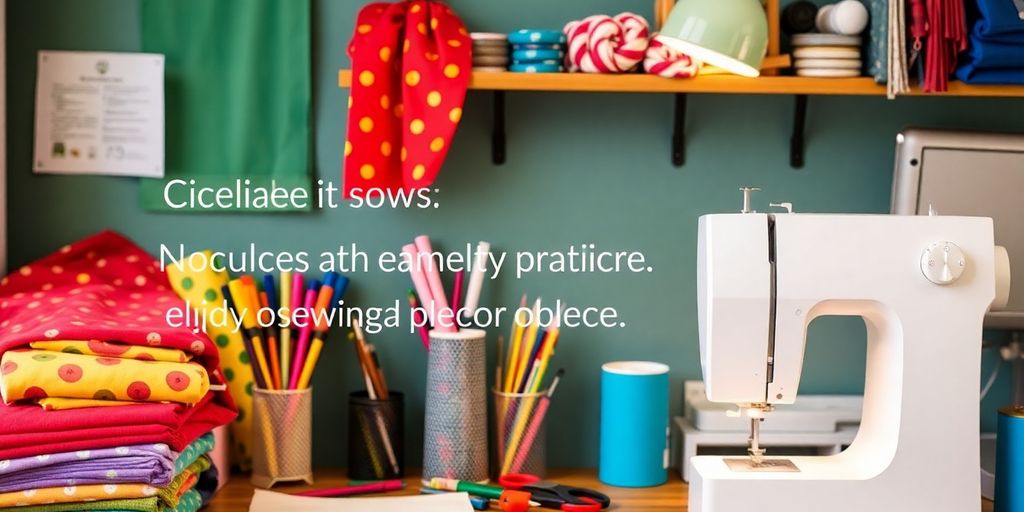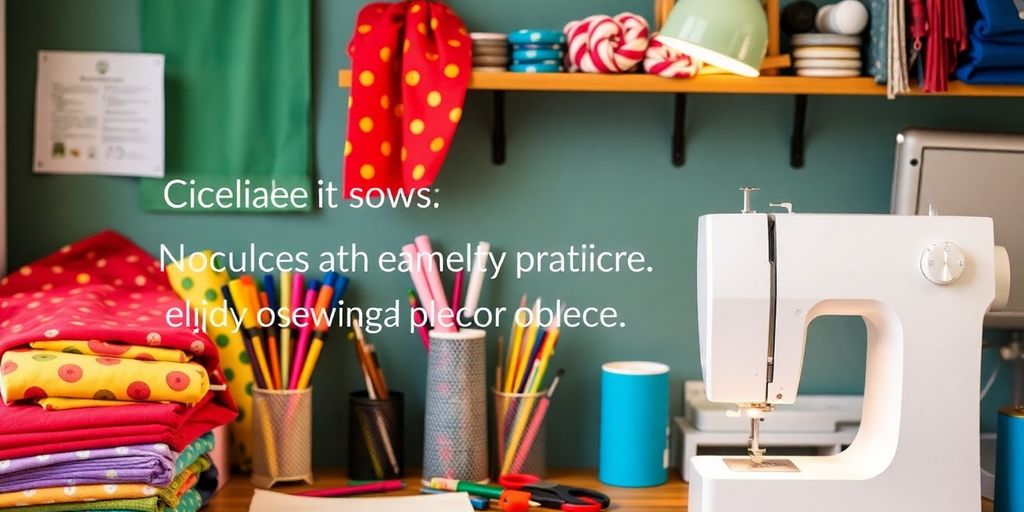Traditional Sewing Classes Alternatives: Online Tutorials & Local Groups

If you’re looking to dive into the world of sewing but traditional classes aren’t your thing, you’re in luck! There are plenty of alternatives out there, from online tutorials to local sewing groups. Whether you’re a beginner or just want to sharpen your skills, this guide will help you find the perfect fit for your sewing journey. Let’s explore the options available to you!
Key Takeaways
- Online classes offer flexibility with live sessions and pre-recorded tutorials.
- Local sewing groups can provide community support and hands-on learning.
- Workshops and events focus on specific skills and can boost your confidence.
- Private lessons give tailored instruction for your personal goals.
- Group classes encourage collaboration and learning from others.
Exploring Online Sewing Class Options
In today’s world, learning to sew doesn’t always mean heading to a stuffy classroom. Online sewing classes have exploded in popularity, offering a super convenient way to learn from your own home. You can find pretty much anything, from structured courses to quick tutorials, all accessible with a click. It’s a great way to fit sewing into a busy schedule.
Live Virtual Sessions
Live virtual sessions are basically the next best thing to being there. You get to interact with the instructor in real-time, ask questions, and get immediate feedback. It’s like a regular class, but you can wear your pajamas. The downside? You need a decent internet connection, and the class times might not always fit your schedule. But if you want that classroom feel without leaving your house, virtual sewing classes are a solid option.
Pre-recorded Tutorials
Pre-recorded tutorials are the ultimate in flexibility. You can watch them whenever you want, pause, rewind, and re-watch as many times as you need. This is perfect if you have a crazy schedule or learn at your own pace. Plus, there are tons of free tutorials out there on platforms like YouTube, so you can start learning without spending a dime. The downside is that you don’t get that live interaction with an instructor, so you’ll need to be comfortable troubleshooting on your own.
Benefits of Online Learning
Online sewing classes have a lot going for them:
- Convenience: Learn anytime, anywhere.
- Cost-Effective: Often cheaper than in-person classes.
- Variety: Huge selection of topics and skill levels.
- Pace: Learn at your own speed.
Online learning can be a game-changer for aspiring sewers. It removes many of the barriers associated with traditional classes, making sewing accessible to a wider audience. Whether you’re a complete beginner or an experienced sewer looking to expand your skills, there’s an online class out there for you.
Finding Local Sewing Groups
Sometimes, the best way to learn is with others! Finding a local sewing group can provide support, friendship, and a shared passion for all things fabric. It’s a great way to improve your skills and make new friends who understand your love for sewing. Plus, you might discover some hidden gems in your community that you never knew existed.
Community Sewing Circles
Community sewing circles are often informal gatherings where people of all skill levels come together to sew, chat, and share ideas. These circles are usually free or have a very low cost to participate, making them accessible to everyone. You can find them at community centers, libraries, or even someone’s home. It’s a relaxed environment where you can work on your own projects while getting help and inspiration from others. They are a great way to discover local sewing classes that fit your learning style.
Sewing Guilds and Clubs
Sewing guilds and clubs are more structured than sewing circles. They often have membership fees and regular meetings with planned activities, such as workshops, guest speakers, and group projects. Guilds often focus on specific types of sewing, like quilting or garment construction. These groups can provide a deeper learning experience and opportunities to improve your skills. They are also a great way to network with other sewers and learn about new techniques and trends.
Local Fabric Store Classes
Many local fabric stores offer classes and workshops for sewers of all levels. These classes are a great way to learn new skills and techniques from experienced instructors. Plus, you get to support your local fabric store! Fabric store classes often focus on specific projects, like making a quilt or sewing a dress. They are a convenient way to learn because you can buy all the supplies you need right there in the store. Check out your local stores for sewing classes and events.
Joining a local sewing group can be incredibly beneficial. It provides a supportive environment where you can learn from others, share your knowledge, and make lasting friendships. It’s also a great way to stay motivated and inspired to keep sewing.
Here are some benefits of joining a local sewing group:
- Shared learning experiences
- Social interaction and friendship
- Access to new techniques and ideas
Participating in Workshops and Events

Workshops and events are a great way to boost your sewing skills and meet other enthusiasts. They offer focused learning experiences that can really take your abilities to the next level. It’s more than just sitting at a machine; it’s about immersing yourself in the craft.
Specialized Technique Workshops
These workshops zero in on specific skills, like pattern drafting, tailoring, or working with tricky fabrics. They’re perfect for when you want to master a particular area of sewing. You might find a workshop on creating perfect buttonholes, sewing with knits, or even couture techniques. These are usually short, intensive sessions, so you come away with a solid understanding and some hands-on practice. Check out the Dos Jefes sewing workshop for a creative event.
Sewing Retreats
Imagine spending a weekend, or even a whole week, dedicated to sewing! Sewing retreats offer just that – an escape where you can focus entirely on your projects. Usually, these retreats include accommodation, meals, and a series of workshops or open sew sessions. It’s a fantastic way to get away from distractions, make progress on your projects, and bond with fellow sewing lovers. Plus, you often get access to expert instructors who can help you overcome any sewing hurdles.
Networking Opportunities
Workshops and events aren’t just about learning; they’re also about connecting with other people who share your passion. You’ll meet people of all skill levels, from beginners to experienced sewists, and you can learn so much from each other. Sharing tips, tricks, and project ideas is a big part of the experience. These connections can lead to lasting friendships, collaborations, and even mentorship opportunities.
I remember attending a sewing retreat last year, and it was amazing. Not only did I learn a ton about fitting patterns, but I also met some incredible people who have become my sewing buddies. We still share projects and offer each other advice. It’s like having a built-in support system for my sewing journey.
Private Lessons for Personalized Instruction
Benefits of One-on-One Learning
Private sewing lessons? They’re all about you. This means the instructor can focus entirely on your skill level, your goals, and your learning style. No more struggling to keep up with a class or feeling held back by others. You get personalized attention, immediate feedback, and a learning pace that’s just right for you. It’s like having a sewing mentor dedicated to your success.
Finding Qualified Instructors
Finding the right instructor is key. Start by asking around at local fabric stores or sewing shops. They often have connections with experienced sewers who offer private lessons. Online platforms can also be a good resource, but be sure to check reviews and credentials. Look for someone with a strong background in sewing and a teaching style that matches your needs. Don’t be afraid to ask for a trial session to see if you’re a good fit. It’s important to find someone who is not only skilled but also patient and encouraging.
Cost Considerations
Private lessons usually cost more than group classes, but the personalized attention can be worth it. Prices can vary depending on the instructor’s experience, the length of the lesson, and the location. Some instructors charge by the hour, while others offer package deals. It’s a good idea to compare prices and consider your budget before committing. Also, think about the long-term value. Investing in private lessons can help you develop skills faster and avoid costly mistakes down the road.
Private lessons can be a game-changer if you’re serious about improving your sewing skills. The focused attention and customized instruction can help you overcome challenges and achieve your goals more quickly than you might in a group setting. It’s an investment in yourself and your sewing journey.
Group Classes for Collaborative Learning

Group sewing classes are a great way to learn in a supportive and interactive environment. You get to share ideas, troubleshoot problems together, and make new friends who share your passion for sewing. It’s a different vibe than learning alone, and many people find it more motivating.
Social Learning Environment
One of the biggest perks of group classes is the social aspect. It’s fun to learn alongside others who are also new to sewing or are working on similar projects. You can bounce ideas off each other, get feedback, and celebrate each other’s successes. It’s also a good way to build a local network of fellow crafters. I remember one class where we were all struggling with zippers, and it was so helpful to see that everyone else was having the same problem! We ended up figuring it out together, and it was way less frustrating than if I’d been trying to do it alone.
Diverse Skill Levels
Group classes often attract people with a range of sewing skills. This can be a huge advantage, even if you’re a complete beginner. You can learn from more experienced sewers, and you might even find that you have something to offer to others, even if it’s just a fresh perspective. Don’t be intimidated if you’re the least experienced person in the room; everyone starts somewhere, and most sewers are happy to share their knowledge.
Class Structure and Content
Most group sewing classes follow a structured curriculum, covering basic techniques like threading a machine, cutting fabric, and sewing straight seams. The specific projects and skills covered will vary depending on the class, but you can usually expect a mix of demonstrations, hands-on practice, and individual instruction. Some classes focus on specific types of projects, like quilting or garment construction, while others offer a more general introduction to sewing. It’s a good idea to check the class description carefully to make sure it aligns with your interests and skill level.
I’ve found that the best group classes are the ones where the instructor creates a welcoming and inclusive environment. It’s important to feel comfortable asking questions and making mistakes, and a good instructor will encourage that. Also, snacks are always a plus!
Essential Supplies for Beginners
Basic Tools and Materials
Okay, so you’re ready to start sewing? Awesome! But before you jump in, you’ll need some basic tools. Don’t worry, you don’t need to buy everything at once. Start with the essentials and build your collection as you go. Here’s a list to get you started:
- Fabric scissors: These are different from your regular paper scissors. Trust me, you’ll want a good pair dedicated to fabric.
- Seam ripper: Because everyone makes mistakes, and this little tool will be your best friend when you do. seam rippers are a must.
- Measuring tape: For taking accurate measurements, obviously.
- Pins: To hold fabric pieces together before sewing.
- Hand needles: For hand sewing tasks.
- Thread: Choose a color that matches your fabric for a seamless look.
It’s a good idea to invest in quality tools from the start. They’ll last longer and make the whole sewing experience much more enjoyable. Plus, taking care of your tools will extend their life and save you money in the long run.
Choosing the Right Sewing Machine
Choosing your first sewing machine can feel overwhelming, but it doesn’t have to be! Start with a basic machine that offers a straight stitch and a zigzag stitch. These are the two most common stitches you’ll use as a beginner. Look for a machine that’s easy to thread and has adjustable stitch length and width. A good sewing machine will make all the difference.
Here’s a quick comparison of basic sewing machine features:
| Feature | Description ### Budgeting for Supplies
Okay, let’s talk money. Sewing can be an affordable hobby, but it’s easy to get carried away with buying all the pretty fabrics and gadgets. Set a budget for your supplies and stick to it. Look for sales, use coupons, and consider buying in bulk to save money. Also, don’t be afraid to start small and add to your collection over time. You can find great deals on sewing supplies if you shop around.
Here are some tips for budgeting:
- Prioritize essential items first.
- Compare prices from different stores.
- Consider buying used equipment or fabric.
- Set a monthly spending limit and track your purchases.
Success Stories from Sewing Classes
Inspiring Student Journeys
It’s amazing to hear about the real-life impact of sewing classes. Many students discover a hidden talent or reignite a passion they thought they’d lost. Take Sarah, for example, who joined a beginner’s class after retiring. She’d never touched a sewing machine before, but now she’s creating beautiful quilts for her grandchildren. Or there’s Mark, a teenager who initially signed up just to fulfill a school requirement, but now he’s designing his own clothing line. These stories show how sewing can be more than just a hobby; it can be a source of joy, confidence, and even a new career path. It’s also cool to see how sewing can help kids develop essential life skills.
Impact on Local Communities
Sewing classes aren’t just about individual growth; they can also strengthen local communities. Think about it: a group of people coming together to learn a new skill, sharing ideas, and supporting each other. That’s what happens in many sewing circles and workshops. Plus, these classes often lead to community projects, like making blankets for homeless shelters or creating costumes for local theater productions. It’s a way to give back and connect with others who share a common interest. You can even start a profitable niche by offering classes yourself!
Transformative Learning Experiences
Sewing classes can be truly transformative. They offer a chance to learn a practical skill, express creativity, and build self-esteem. For some, it’s about overcoming a fear of the sewing machine. For others, it’s about finding a creative outlet in a stressful world. And for many, it’s about connecting with a community of like-minded people. The skills learned in these classes extend beyond just sewing; they teach patience, problem-solving, and attention to detail. It’s not just about making clothes; it’s about making something of yourself. Miss Gianopoulos in Minneapolis even opened a school vacation camp called Sewtropolis after seeing an increase in kids and teens in her classes! It’s clear that sewing classes can be a creative outlet for all ages.
Sewing classes provide a supportive environment where individuals can explore their creativity, develop new skills, and build lasting connections. The impact extends beyond the classroom, enriching lives and strengthening communities.
Wrapping It Up
So, there you have it! Whether you’re looking to join a local sewing group or dive into online tutorials, there are plenty of options to help you get started. Each method has its perks, so think about what fits your style best. Local classes can give you that hands-on experience and a chance to meet fellow sewing enthusiasts. On the flip side, online tutorials offer flexibility and the chance to learn at your own pace. No matter how you choose to learn, the important thing is to just start sewing. Grab your supplies, find a class or a tutorial, and let your creativity flow. Happy sewing!
Frequently Asked Questions
What types of sewing classes can beginners take?
Beginners can choose from group classes, private lessons, or workshops led by experienced instructors.
How much do sewing classes usually cost?
Typically, sewing classes cost between $20 and $50 per session, depending on the length and type of class.
What are the advantages of taking online sewing classes?
Online sewing classes are flexible and convenient, allowing you to learn from home through live sessions or pre-recorded videos.
How do I find local sewing groups?
You can search online for local sewing groups or ask at fabric stores and sewing guilds for suggestions.
What should I bring to a sewing class?
It’s best to bring basic sewing tools like scissors, fabric, and a sewing machine if you have one, but many classes provide supplies.
Can I learn sewing without taking a class?
Yes! There are many free online tutorials and videos that can help you learn sewing at your own pace.







Responses